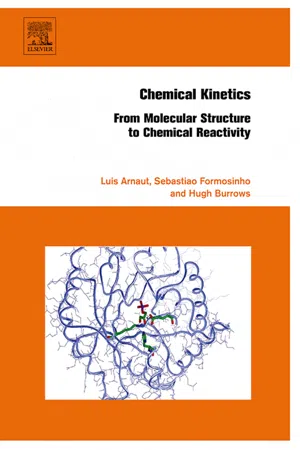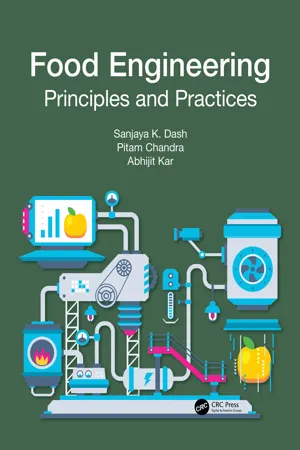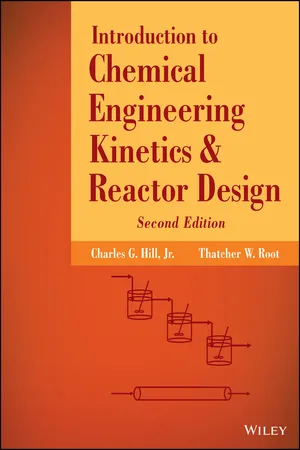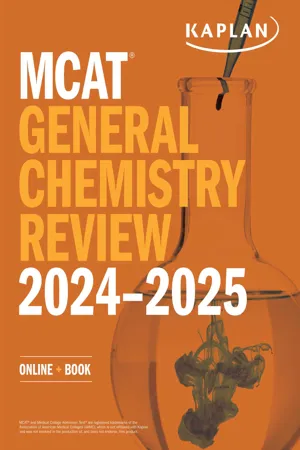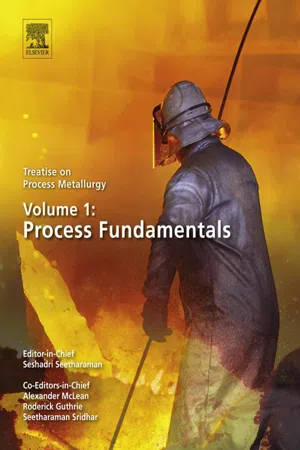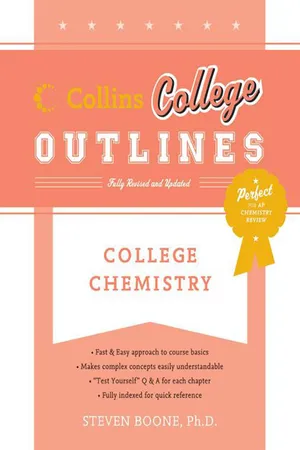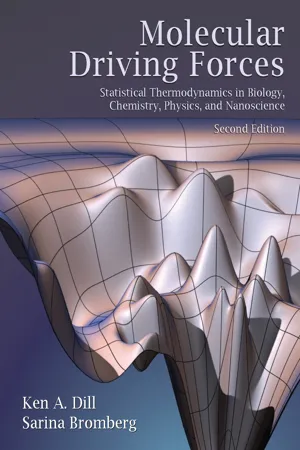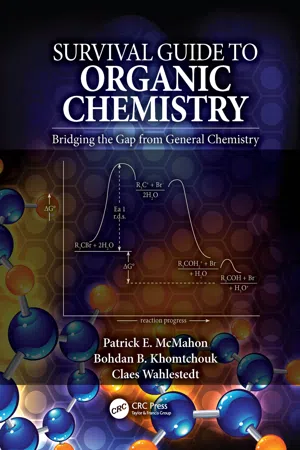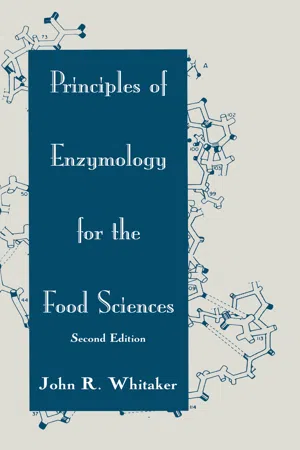Chemistry
Factors Affecting Reaction Rates
Factors affecting reaction rates include concentration, temperature, surface area, catalysts, and the nature of the reactants. Increasing the concentration of reactants or the temperature generally speeds up reactions, while larger surface areas and catalysts can also accelerate the rate. The nature of the reactants, such as their chemical structure and reactivity, also plays a significant role in determining reaction rates.
Written by Perlego with AI-assistance
Related key terms
Related key terms
1 of 4
Related key terms
1 of 3
11 Key excerpts on "Factors Affecting Reaction Rates"
- eBook - ePub
Chemical Kinetics
From Molecular Structure to Chemical Reactivity
- Luis Arnaut, Hugh Burrows(Authors)
- 2006(Publication Date)
- Elsevier Science(Publisher)
2Reaction Rate Laws
Publisher Summary
This chapter discusses the factors involved in determining the rates of chemical reaction. The velocities of elementary chemical reactions depend on a number of factors, in particular the nature of the reactants, concentrations or pressures, temperature, light, catalysts, and the solvent used. The great variation observed in reaction velocities is related first to the nature of the reagents. Secondly, all reaction rates depend on the concentration of reagents, while for reversible reactions those of products also affect them. These reactions also depend on rate constant and temperature; the temperature dependence comes from the exponential term. The effect of light on chemical reactions is well known from the processes of photosynthesis and photography. Catalysts do not alter the position of equilibrium in a reaction. Their effect, instead, arises from the fact that in their presence a pathway with lower activation energy becomes available to the reactants.2.1 REACTION RATES
The rate of conversion for the general form of a chemical reaction,(2.I)v AA +v BB + ⋅ ⋅ ⋅ →v XX +v YY + ⋅ ⋅ ⋅(2.I)where v A , v B , v X and v Y are the stoichiometric coefficients of the species involved, can be expressed in terms of a single parameter ξ, which is known as the extent of reaction, and is defined by [1]ξ =(2.1)n i( ξ ) −n i( 0 )v i(2.1)Here, i represents any of the reactants or products,nithe number of moles of i in the chemical reaction (positive for products and negative for reactants),ni(0) the amount of i present when v = 0 (that is before the start of the reaction) andni(ξ) the amount of i present at extent of reaction ξ.The rate of conversion in a chemical reaction is defined as the variation of ξ with time, t ,r =(2.2)d ξd t(2.2)Using the definition of ξ from eq. (2.1) - eBook - ePub
Food Engineering
Principles and Practices
- Sanjaya K. Dash, Pitam Chandra, Abhijit Kar(Authors)
- 2023(Publication Date)
- CRC Press(Publisher)
The temperature dependence of a reaction rate is generally explained by the Arrhenius equation. As a rule of thumb for many reactions, every 10°C increase in temperature leads to a doubling of the reaction rate.In some rare situations, the reaction rate is not affected by the temperature (called non-Arrhenius behavior) or there may be a decrease in the reaction rate with an increase in temperature (anti-Arrhenius). The rate constant decreases with a temperature increase for those reactions that have no activation barrier (e.g., some radical reactions).- Surface area. The reaction rate increases with an increase in the surface area as more solid particles are exposed for the reaction. Stirring strongly influences the rates for heterogeneous reactions.
- Order of reaction. It controls the reaction rate by managing the reactant concentration (or pressure).
- Solvent. The properties of the solvent in a solution and the ionic strength affect the reaction rate.
- Intensity of electromagnetic radiation. Electromagnetic radiation imparts energy to the reactants and may accelerate the reactions. An increase in the radiation intensity will increase the reaction rate.
- Presence of catalyst. The rate of reaction is accelerated by the presence of a catalyst in both forward and reverse directions.
Out of all the factors mentioned above, the temperature is the most important one affecting the rate of reaction. Also, as we discussed, the rate equation consists of three parameters, viz., concentration; the rate constant, k; and the reaction order. Thus, all the above factors, except concentration and order, are considered in the rate constant, k.4.3 Influence of Temperature on Rate of Reaction
The Arrhenius equation - Charles G. Hill, Thatcher W. Root(Authors)
- 2014(Publication Date)
- Wiley(Publisher)
the rate of reaction observed is not identical with the intrinsic chemical reaction rate evaluated using the bulk fluid properties. The rate observed in the laboratory reflects the effects of both chemical and physical rate processes. The intrinsic rate may be thought of as the conversion rate that would exist if all physical rate processes occurred at infinitely fast rates.Situations in which both physical (e.g., mass transfer, diffusion, or heat transfer) and chemical rate processes influence the conversion rate are discussed in Chapter 12; the present chapter is concerned only with those situations for which the effects of physical rate processes are unimportant. This approach permits us to focus our concern on the variables that influence intrinsic chemical reaction rates (i.e., temperature, pressure, composition, and the presence or absence of catalysts in the system).In reaction rate studies one's goal is a phenomenological description of a system in terms of a limited number of empirical constants. Such descriptions permit one to predict the time-dependent behavior of similar systems. In these studies the usual procedure is to try to isolate the effects of the different variables and to investigate each independently. For example, one encloses the reacting system in a thermostat to maintain it at a constant temperature.Several generalizations can be made about the variables that influence reaction rates. Those that follow are in large measure adapted from Boudart's text (1).- The rate of a chemical reaction depends on the temperature, pressure, and composition of the system under investigation.
- Certain species that do not appear in the stoichiometric equation for the reaction under study can markedly affect the reaction rate, even when they are present in only trace amounts. These materials are known as catalysts or inhibitors
- No longer available |Learn more
MCAT General Chemistry Review 2024-2025
Online + Book
- (Author)
- 2023(Publication Date)
- Kaplan Test Prep(Publisher)
CHAPTER 5CHEMICAL KINETICS
In This Chapter
5.1 Chemical KineticsReaction Mechanisms Molecular Basis of Chemical Reactions Factors Affecting Reaction RateDefinition of Rate Determination of Rate Law Reaction Orders5.2 Reaction RatesConcept SummaryCHAPTER PROFILE
The content in this chapter should be relevant to about 11% of all questions about general chemistry on the MCAT. This chapter covers material from the following AAMC content categories:1A: Structure and function of proteins and their constituent amino acids5E: Principles of chemical thermodynamics and kineticsIntroduction
The following chapters focus on two primary topics: chemical kinetics and chemical equilibrium. As the term suggests, chemical kinetics is the study of reaction rates, the effects of reaction conditions on these rates, and the mechanisms implied by such observations. We start with kinetics because the molecular basis of reactions provides us with a framework of reaction chemistry. Following this, we will explore the equilibria of these reactions, which are related to—but distinct from—the kinetics of the reactions.You may already have a fairly good understanding of equilibrium and the differences between spontaneous and nonspontaneous reactions. For instance, the utilization of ATP in the body is a spontaneous reaction that can be used to provide thermochemical energy for other reactions. While the equilibrium tells us that ATP will favor dissociation, it tells us nothing about its rate of dissociation. And, in fact, various conditions in the body can alter the rate at which ATP is synthesized and utilized for energy—primarily temperature. Some of the symptoms of hyper- and hypothermia are related to changes in metabolism caused by changes in temperature and reaction kinetics. - eBook - ePub
Chemistry
With Inorganic Qualitative Analysis
- Therald Moeller(Author)
- 2012(Publication Date)
- Academic Press(Publisher)
15CHEMICAL KINETICS
Publisher Summary
This chapter discusses atoms, molecules, or ions as they collide, the conditions under which they might react with each other, and the energy changes involved. It explains how the concentration of the reactants, the temperature, the amount of contact among the reacting substances, and catalysis can affect reaction rates. The chapter further explains chemical kinetics. It discusses reaction mechanisms and the interpretation of rate equations. It discusses the transition state theory and presents that reaction rate varies with nature of reactants, concentrations, temperature, contact, and catalysis. A catalyst increases the rate of a chemical reaction, but can be recovered in its original form when the reaction is finished. The reaction rate is the speed with which the products are produced and the reactants are consumed in a specific reaction. It is usually discussed in terms of the rate at which one component of the mixture is used up or formed. A rate equation gives the relationship between the reaction rate and the concentration of the reactants. The chapter illustrates first order reaction and second order reaction.In this chapter we first look at two atoms, molecules, or ions as they collide, the conditions under which they might react with each other, and the energy changes involved. Next we examine in a general way how the concentration of the reactants, the temperature, the amount of contact between the reacting substances, and catalysis can affect reaction rates. Finally, we introduce the terminology and mathematics of chemical kinetics and briefly discuss reaction mechanisms and the interpretation of rate equations. In the next chapterwe go on to discuss chemical equilibrium.Achemical equation tells us what the reactants and products are in a particular reaction. It tells us nothing about the pathway from reactants to products, or how much of the products will actually be formed, or the speed of the reaction - eBook - ePub
- Pieter Walstra(Author)
- 2002(Publication Date)
- CRC Press(Publisher)
4 Reaction Kinetics
Chemical kinetics is generally discussed with respect to reactions between molecules (or ions or radicals) in a gas phase or in a very dilute solution. In foods, we often have other situations. The system never is gaseous, it is rarely very dilute, and it may have more than one phase containing reactants. Changes may occur within molecules, especially macromolecules. Reactions may be between particles, causing, for instance, their aggregation. Numerous other changes may occur, such as phase transitions, leading to a change in rheological properties, color, or other perceptible property. In nearly all such cases we are greatly interested in the rate at which these processes occur. This we cannot derive from the bond energies involved or from other thermodynamic considerations: these may tell us what the driving force is, but in general the rate results from a driving force divided by a resistance, and the resistance may be very large or highly variable.In this chapter, we will recall some basic aspects of chemical reaction kinetics in solution, starting from an oversimplified point of view and gradually bringing in more complications. We will not discuss theory aimed at explaining reaction rates on a molecular level (molecular reaction dynamics). Other rate processes will be discussed in Chapters 5 and 13 .4.1 REACTION ORDER
Before coming to factors determining reaction rates, it is useful to review the manner in which concentrations depend on time.The reaction rate is usually given as the change in concentration c, i.e., as either + or -dc/dt. According to the units of c, it may be expressed in mol·L-1 ·s-1 (the most common way), mol·kg-1·s-1 , number ·m-3·s-1 , etc.For a zero-order reaction, the rate remains constant: see Table 4.1 - (Author)
- 2013(Publication Date)
- Elsevier(Publisher)
Chapter 4.7Factors Influencing Reaction Area
Peter Hayes, School of Chemical Engineering, The University of Queensland, Queensland, Brisbane, Australia4.7.1 Introduction
By now, the reader will be familiar with the general rate equation introduced in Chapter 4.2 to describe the instantaneous rate of heterogeneous reaction(4.7.1)where C I and C I i are the concentrations of the species in the bulk phase and at the interface in phase I, respectively, K is the apparent equilibrium constant, and A is the interface area. The many factors influencing the rate constants k mI , k c , and k mII have already been discussed in this chapter. Attention is now turned to the parameter A , the interfacial area. Clearly, this is also a key process parameter determining rates of these heterogeneous reactions. To emphasis its importance, this factor is explicitly addressed and discussed in the following section. The interfacial area available for chemical reaction in reaction system is determined by the(i) Process conditions imposed on the system, (ii) Reaction induced mechanisms, and (iii) Time or extent of reaction.These factors are summarized in Table 4.7.1 and examples of each are presented and discussed in more detail below.Table 4.7.1 Summary of Factors Influencing Interfacial Area in Reaction SystemsThe most common assumption made in describing reaction systems is that the shape of the reactant materials or system geometry does not change over time or extent of reaction, or if it does, it is in a well-defined way.In reality, all materials are continuously changing their shape either at an atomic or macroscopic scale. The first thing to establish in the analysis is the extent of these changes and how fast they are occurring relative to other process that are taking place in the reaction system. If the shape changes do not influence the rate limiting reaction steps or are slow compared to other reaction steps then the assumption of constant shape or geometry may be valid, if not these changes must be taken into account in any quantitative analysis of the process kinetics.- No longer available |Learn more
- Steven Boone, Drew H. Wolfe(Authors)
- 2011(Publication Date)
- Collins Reference(Publisher)
CHAPTER 14Rates of Chemical Reactions
C hemical kinetics , also called reaction kinetics , is the study of the rates of chemical reactions and the underlying mechanisms by which reactants change to products. An important outcome for studying the rates of chemical reactions is to develop an understanding of how chemical reactions take place. Chemists attempt to identify the molecular events that occur as reactants change to products. The series of steps that take place in a reaction is termed the reaction mechanism .14.1 RATES OF CHEMICAL REACTIONSThe enthalpy and entropy change in a chemical reaction is used to predict the spontaneity of the reaction (see Chapter 18), however, it provides no information regarding how long the reaction will take to reach completion, which is kinetics.Reaction RatesA rate refers to a change that occurs over a time interval. Chemical reaction rates may be monitored by measuring the change in concentration or pressure of a reactant or product over a time interval. Recall that the Greek letter delta, Δ, is used to represent a change. Therefore, this expression may be represented as follows.Exercise 14.1Consider the rate of the gas-phase reaction when nitrosyl fluoride, ONF, forms from F2 and NO.F2 (g) + 2NO(g) → 2ONF(g)(a) Write an expression that shows the rate of formation of ONF. (b) What are the units of reaction rate? (c) Write an expression that shows the rate of disappearance of NO. (d) Write an expression that shows the relationship between the rate of formation of ONF and rate of disappearance of NO. (e) Write an expression that shows the relationship between the rates of disappearance of F2 - eBook - ePub
Molecular Driving Forces
Statistical Thermodynamics in Biology, Chemistry, Physics, and Nanoscience
- Ken Dill, Sarina Bromberg(Authors)
- 2010(Publication Date)
- Garland Science(Publisher)
19 Chemical Kinetics & Transition States Chemical Reaction Rates Depend on TemperatureNow, we focus on the kinetics of chemical reactions. To predict how the rate of a chemical reaction depends on its molecular structures, you can use the same statistical thermodynamics approach that we used in Chapter 13 to model equilibria. Chemical reactions typically speed up more strongly with temperature than physical processes do. To understand this, you need one additional concept: the transition state or activation barrier.The Mass Action Laws Describe Mechanisms in Chemical KineticsConsider a chemical reaction in which a product P is produced from reactants A, B, and C, with stoichiometric coefficients a, b, and c:a A + b B + c C → P .(19.1) In general, the reaction rate depends on the concentrations of the reactants, the temperature and pressure, and the coefficients a, b, and c. Experiments often measure how reaction rates depend on the concentrations of the reactants. Such experiments can provide valuable information about the mechanism of the reaction.The kinetic law of mass action, first developed by CM Guldberg and P Waage in 1864, says that reaction rates should depend on stoichiometry in the same way that equilibrium constants do. According to this law, the initial rate of product formation, d[P]/dt for the reaction in Equation (19.1) , depends on the reactant concentrations:=d[ P ]d tk f[ A ]a[ B ]b,[ C ]c(19.2) where kf is the rate coefficient for the forward reaction. However, kinetic mechanisms often do not follow the thermodynamic stoichiometries. If a reaction is a single step, called an elementary reaction, then such expressions apply. The main types of elementary reactions are unimolecular decay of a molecule (a = 1, b = c = 0) or a bimolecular reaction when two molecules come together (a = b = 1, c = 0). However, chemical reactions typically involve multiple steps and kinetic intermediate states. For such non-elementary reactions, you cannot express the rate equation in such simple stoichiometric terms. At present, rate laws can only be determined from experiments. We do not address reaction mechanisms here; they are described in chemical kinetics textbooks such as [1 , 2 - eBook - ePub
Survival Guide to Organic Chemistry
Bridging the Gap from General Chemistry
- Patrick E. McMahon, Bohdan B. Khomtchouk, Claes Wahlestedt(Authors)
- 2016(Publication Date)
- CRC Press(Publisher)
rate expression or rate law:rate( r )= k[xreactant 1][reactant 2]y… .- The constant in the expression is called the rate constant, k; the numerical values of the exponents x, y, etc. are called the reactant orders . For example, if x = 2 in the above general expression, the reaction is “second-order in reactant 1.”
- The sum of all the exponents x + y ... is called the reaction order . For example, if x = 2 and y = 1 in the above general expression, the reaction would be described as a “third-order reaction.”
- The values of k, x, y ... depend on the mechanistic steps .
9.1.3 ADDITIONAL VARIABLES AFFECTING REACTION RATES
- Rates are inversely proportional to the energy barriers that prevent a specific reaction step from occurring; this barrier is called the activation energy , or activation barrier for this step (general symbol: Ea ).
- The activation energy, Ea , represents the energy that must be added to reactants to allow bonding changes to occur.
- A reaction rate will increase as the activation energy (barrier) decreases. Ea is a path function and does not depend directly on ΔG for the complete reaction. The specific Ea, most important for a complete reaction containing many steps, depends on the mechanism.
- eBook - ePub
- John R. Whitaker(Author)
- 2018(Publication Date)
- Routledge(Publisher)
max determined), the effect of temperature on the rate-determining step in conversion of enzyme-substrate complex to products can be determined. This ratedetermining step may involve covalent bond formation, covalent bond breakage, dissociation of product from enzyme, or enzyme conformational changes. The rate-determining step may be different with different substrates, at different pH values, and may change with temperature. If more than one step in a reaction contributes to the observed rate of a reaction, the observed effect of temperature will be a composite of effect of temperature on each of those steps.A. Quantitation of Effect of Temperature on Rates of Reactions
A number of methods are available for quantitatively expressing the effect of temperature on rate of transformation of substrate to product. Each of these methods will be examined briefly for what it has to offer.1 Q 10
A term often used in biology is that of Q 10 · Q 10 is defined as the increase in rate of a reaction for a 10°C increase in temperature:(13)Q 10=rateT + 10 °rate TIt is determined by observing the rates of a reaction at two temperatures 10°C apart. The Q 10 values for most chemical and enzymatic reactions fall within the range 1.5 to 3. Although the difference between a Q 10 of 2 and 3 does not look large, consider the relative rates (based on 1 at 0°C) of 243 versus 32 at 50°C for a (210 of 3 and 2, respectively (Table 3 ). Such comparisons point out that the relationship between Q 10 and rate is logarithmic rather than linear:Table 3 Relative Rates at Different Q 10 Valuesa(14)Δ rate =Q 10 n,where n = Δ T / 10 ° CWhen Q 10 = 2, a 10°C rise in temperature will double the rate of a reaction. It takes a doubling of reactant concentration to double the rate of a first-order process. Therefore, the effect of temperature on rates of reactions are extremely important.2 Arrhenius Equation
The first quantitative, experimental formulation of the dependence of reaction rates on temperature was made by Hood. His formulations were later extended and made into a general equation by Arrhenius. The dependence of the specific reaction rate constant, k , on temperature is given byk = A(15)e−E a/ R Twhich may be rewritten as [taking logarithms of both sides of Eq. (15 )]log k = log A −(16)E a2.3 R T
Index pages curate the most relevant extracts from our library of academic textbooks. They’ve been created using an in-house natural language model (NLM), each adding context and meaning to key research topics.
Explore more topic indexes
Explore more topic indexes
1 of 6
Explore more topic indexes
1 of 4
